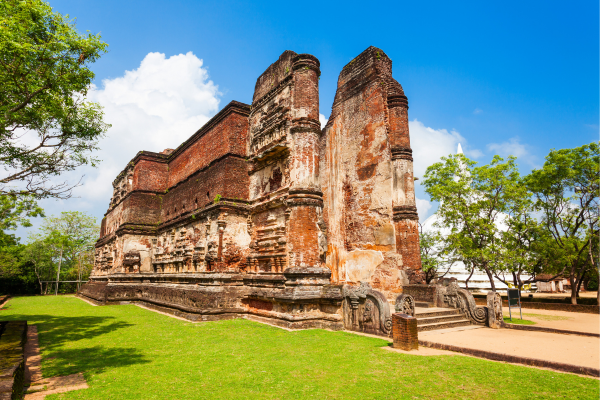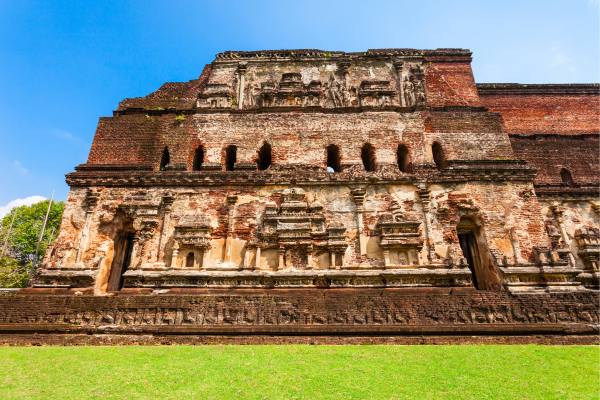historic temple located in Polonnaruwa – Sri Lanka ” Lankatilaka Temple “ – By Malsha – eLanka

The Lankatilaka Buddhist Temple is a historic temple located in Polonnaruwa, Sri Lanka. It was built during the reign of King Parakramabahu the Great in the 12th century and is considered to be one of the finest examples of ancient Sinhalese architecture.
The temple is known for its unique architectural design, which features a large, three-storeyed image house built on a high platform, with a large seated Buddha statue inside. The image house is surrounded by a series of smaller shrines and chapels, which are adorned with beautiful frescoes and intricate carvings.
The Lankatilaka Temple is also famous for its unique blend of Buddhist and Hindu architectural styles, which reflects the religious diversity of Sri Lanka during the medieval period. The temple is a popular tourist attraction and is visited by thousands of visitors each year.
Overall, the Lankatilaka Buddhist Temple is an important cultural and historical site in Sri Lanka, and it provides a fascinating glimpse into the country’s rich and diverse past.
The Lankathilaka Vihara is a historic Buddhist temple located in the ancient city of Polonnaruwa in Sri Lanka. It was built during the reign of King Parakramabahu the Great in the 12th century.
According to historical records, King Parakramabahu was a devout Buddhist and a patron of the arts. He commissioned the construction of several temples and other religious structures throughout his kingdom, including the Lankathilaka Vihara.
The temple was designed by an architect named Sthapati Rayar, who is believed to have been from South India. The temple’s unique architectural style is a blend of Sinhalese, South Indian, and Dravidian influences, and it features a large, three-story image house built on a high platform, with a seated Buddha statue inside.
The temple was built using brick, stone, and stucco, and it was adorned with intricate carvings, beautiful frescoes, and other decorative elements. The temple’s walls are decorated with images of deities, mythical creatures, and scenes from Buddhist stories.
Over the years, the temple fell into disrepair and was abandoned. It was later restored by the Department of Archaeology in Sri Lanka, and it has since become an important cultural and historical site in the country. Today, the Lankathilaka Vihara is a popular tourist attraction, and it attracts thousands of visitors each year who come to marvel at its unique architecture and rich history.

The Lankathilaka Vihara is a unique and impressive temple that features several specialities that make it stand out among other ancient temples in Sri Lanka. Here are a few of its notable features:
- Unique architecture: The Lankathilaka Vihara is renowned for its unique architectural style, which combines elements of Sinhalese, South Indian, and Dravidian styles. The temple’s most striking feature is its large, three-story image house, which is built on a high platform and houses a seated Buddha statue.
- Decorative elements: The temple is adorned with intricate carvings, beautiful frescoes, and other decorative elements. The walls of the temple are covered with images of deities, mythical creatures, and scenes from Buddhist stories, which are considered to be some of the finest examples of ancient Sinhalese art.
- Blend of Buddhist and Hindu influences: The Lankathilaka Vihara reflects the religious diversity of Sri Lanka during the medieval period, as it features a unique blend of Buddhist and Hindu architectural styles. The temple’s design incorporates elements of both religions, including Hindu deities and Buddhist symbolism.
- Location and setting: The temple is situated on a rocky outcrop, which provides a stunning view of the surrounding countryside. Visitors can climb up to the top of the temple to enjoy panoramic views of the area.
Overall, the Lankathilaka Vihara is a remarkable temple that is considered to be one of the finest examples of ancient Sinhalese architecture. Its unique blend of styles, decorative elements, and location make it a must-see attraction for visitors to Sri Lanka.
The Lankathilaka Vihara is an impressive temple located in Polonnaruwa, Sri Lanka. The temple’s architecture is unique and reflects a blend of different influences, including Sinhalese, South Indian, and Dravidian styles. Here are some of the key architectural features of the Lankathilaka Vihara:
- Three-story image house: The temple’s most distinctive feature is its three-story image house, which is built on a high platform and houses a seated Buddha statue. The image house is surrounded by smaller shrines and chapels, which are adorned with intricate carvings and frescoes.
- High platform: The temple is built on a high platform, which is accessed via a steep flight of stairs. The platform provides a commanding view of the surrounding countryside and creates a sense of grandeur and awe.
- Decorative elements: The walls of the temple are adorned with intricate carvings, beautiful frescoes, and other decorative elements. The carvings feature images of deities, mythical creatures, and scenes from Buddhist stories, and are considered to be some of the finest examples of ancient Sinhalese art.
- Blend of Buddhist and Hindu influences: The temple’s architecture reflects the religious diversity of Sri Lanka during the medieval period. The design incorporates elements of both Buddhist and Hindu styles, including Hindu deities and Buddhist symbolism.
- Materials: The temple was constructed using brick, stone, and stucco, and its walls and pillars are decorated with elaborate carvings and sculptures.
Overall, the architecture of the Lankathilaka Vihara is an impressive and unique blend of different styles and influences, and it is considered to be one of the finest examples of ancient Sinhalese architecture.







